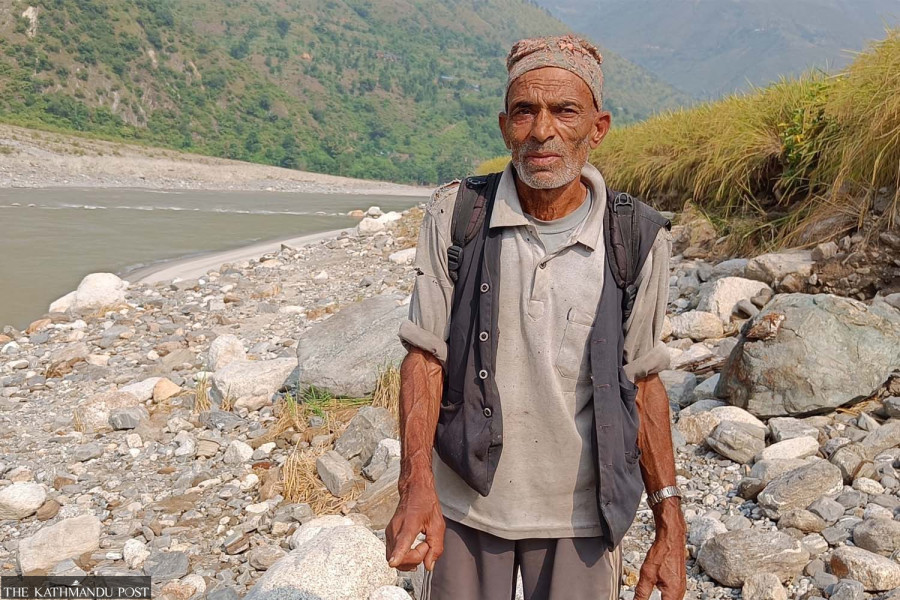Bagmati Province
Displaced flood, landslide victims still without proper shelters
They complain that all three levels of government seem reluctant to provide them with immediate relief and ensure their rehabilitation.
Raj Kumar Karki & Jyoti Shrestha
Dil Bahadur Majhi and his wife, Suntali, have been struggling to build a hut at their ancestral village in Ratnawati of Phikkal Rural Municipality-6, Sindhuli. After the devastating floods in the Sunkoshi river swept away their house and paddy field on September 28, the Majhi couple, with their three children, took shelter in their relative’s house for about three weeks. The disaster destroyed all their properties—house, paddy field and other belongings.
“How long should we stay in our relative’s house?” says Suntali. “The flooded Sunkoshi swept away our house and four ropanies of land. We have nothing left now and the authorities have not supported us for our rehabilitation.”
There was a heap of sand and stones where their house stood before the floods. The Majhi couple leveled the ground, collected some wood and made a shanty with a roof made up of plastic and green branches of trees. The flimsy hut is around 20 metres away from the Sunkoshi river.
Majhi is an indigenous community mostly living in hill districts of Bagmati Province. They have their own language, culture and tradition. The Majhi community is mariginalised and economically backward. They live near the river banks and eke out a living by boating and fishing.
“Our forefathers had been staying here [Ratnawati] for many generations,” says Dil Bahadur. “There were no such big floods in the river in the past. The flooded river this year took away all we had. We celebrated Dashain with the relief distributed by various organisations and begging from the neighbours. But how can we survive now? If the government gives us money to build a house we can do any work and make ends meet.”
Baburam Mishra of Sumtambeshi in Phikkal-2 has been restless after the floods swept away his paddy field. “I had bought three ropanies of land seven years ago at the cost of Rs1.7 million,” Mishra says. “I still have some loans that I took then to purchase the paddy field. What do we eat now and how can I clear the loan?”
His paddy field has turned into a sand bed now.
“We could grow three crops in a year,” Mishra laments. “Around 18 muris of paddy [approximately 1,100 kg] was grown in the field in one season. The floods turned us into paupers.”
Hundreds of farmers have been affected after the floods in Sunkoshi river swept away or damaged paddy fields from Khurkot to Ghurmi in September last week. The floods triggered by heavy rains wreaked havoc in the area, displacing many people.

Hom Kumai Pahadi of Sunambesi and her husband lost their only son a few years ago; her daughter was married off. “We had a good paddy field where we could grow around 12 muris [around 720 kg] of paddy in a season,” Pahadi says. “The daughter was married and the son died. Our livelihood was supported by the paddy field. The floods swept away the paddy field. We have no alternative to urge the government for our livelihood now.”
According to government data, a total of 857 hectares of paddy fields were damaged by the floods in Sindhuli district. Phikkal and Golanjor rural municipalities were the hardest hit.
Situation of the floods- and landslides-affected people is the same in Kavre, another hill district in Bagmati Province. It has been nearly four weeks since the rain-induced disasters occured but almost all the victims are still languishing in displacement. The displaced people are now taking shelter in the houses of their relatives and neighbours while some others take rooms on rent after the floods and landslides destroyed their houses.

Saila Tamang of Bimire in Namobuddha Municipality-11 had a hope that the government would help him after a landslide destroyed his house. “I reconstructed the house after the earthquake in 2015 destroyed the old one,” Tamang says. “The landslide destroyed it again. My wife is sick with a heart ailment. The land that I have is prone to landslides. I don’t have a safer land plot and money to build the house.”
According to Tamang, his wife is currently receiving treatment at Kathmandu Medical College in Sinamagal, Kathmandu. “Around Rs20,000 is already spent. I don’t know how much money we need for her treatment,” he says, adding that he came to the village upon hearing that some organisations are distributing relief.
The displaced people complain that all three levels of government seem reluctant to provide them immediate reliefs and manage for their rehabilitation. According to Chief District Officer of Kavre Umesh Kumar Dhakal, the district administration office decided to provide Rs15,000 to Rs20,000 to each displaced family as immediate relief to manage food and shelter. But most of the victims are yet to receive the announced relief.
The rain-induced disasters wreaked havoc in several districts across the country in the last week of September. The Bagmati and Koshi provinces were the hardest hit by the floods and landslides. Kathmandu Valley, Kavre, Ramechhap, Sindhuli, Dolakha, and Dhading districts were hugely affected as the floods in several rivers and the landslides destroyed houses and public infrastructure including roads, offices, drinking water projects, and utility poles.
The government declared dozens of local units in 14 most affected districts as ‘disaster crisis zones’ with the objectives of expediting rehabilitation, recovery and reconstruction efforts. However, the relief and rehabilitation works have not been carried out effectively, leaving hundreds of displaced families to fend for themselves.




 22.64°C Kathmandu
22.64°C Kathmandu













